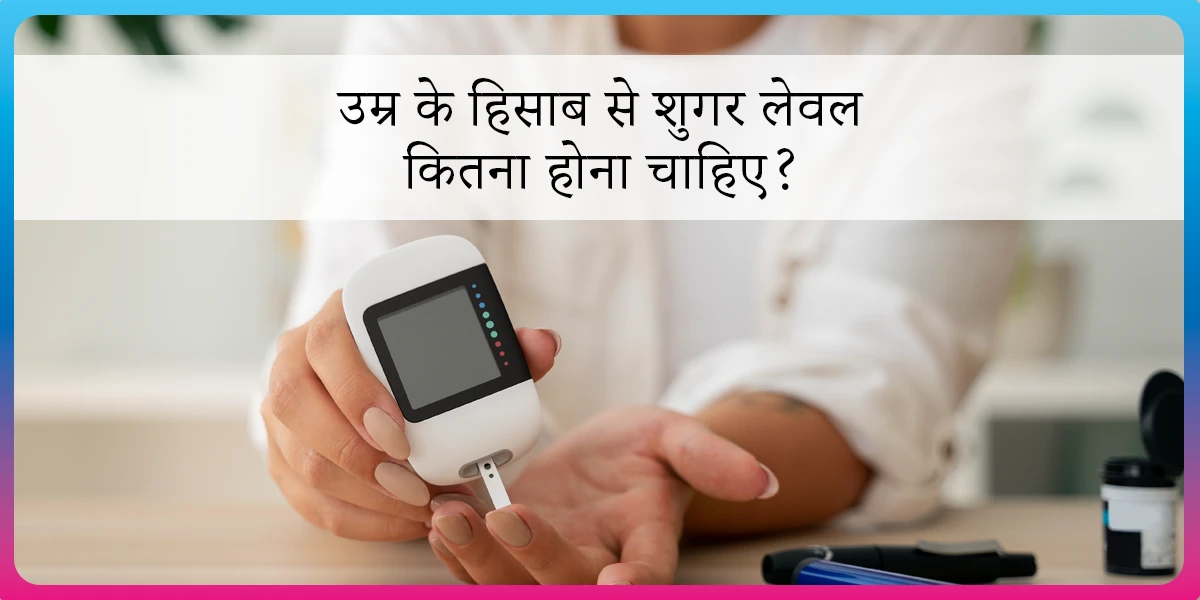Chart of Normal Blood Sugar Levels by Age

A few years ago, diabetes was mostly seen in grown-ups. But times have changed. Today, even children and teenagers are being diagnosed with type 2 diabetes.
That’s why keeping an eye on your blood sugar isn’t just for people who already have diabetes, but it’s important for anyone who has a family history of diabetes or wants to stay on top of their health. The earlier you know, the better your chances of managing or even preventing diabetes.
Let’s find out the normal and recommended blood sugar levels by age, what those numbers actually mean, and how to spot any red flags early.
Why Do Blood Glucose Levels Rise in Diabetes?
Before we jump into blood sugar level charts, we must understand why they tend to rise, especially in people with diabetes.
When you eat food, it is digested and converted into glucose (a type of sugar). This glucose is released into your bloodstream, which causes a rise in blood sugar levels after eating.
Now, here’s where insulin comes in, a hormone made by the pancreas. Its job is to move glucose from your blood into your cells, where it’s used for energy. This helps maintain your blood glucose levels.
Now, in diabetes, one of two things goes wrong:
- Insulin resistance: When your cells don’t respond to insulin in your body (Common in type 2 diabetes).
- Insulin deficiency: Your pancreas doesn’t make enough insulin (Seen in type 1 or juvenile diabetes).
Either way, glucose stays in the bloodstream instead of being used, leading to high blood sugar levels or hyperglycaemia. Over time, uncontrolled high blood sugar can damage your kidneys, eyes, nerves, and heart.
That’s why it’s so important to keep your sugar levels in the recommended range.
What Is a Normal Blood Sugar Level?
According to the American Diabetes Association (ADA), here are the normal blood sugar levels for people who do not have diabetes:
| Test | Normal Range |
| A1C (3-month average) | Less than 5.7% |
| Fasting (before meals) | 100 mg/dL or less |
| Glucose Tolerance Test (GTT) | 140 mg/dL or less |
| Random Blood Sugar | Less than 200 mg/dL |
Note: These are general ranges. Your doctor may suggest different targets based on your age, lifestyle, medications, or existing health conditions.
What is the Normal Range of Blood Sugar by Age?
From children and teenagers to adults and senior citizens – those who do not have diabetes, the normal blood sugar levels chart is usually recommended to be between –
| Condition | Normal blood glucose range |
| Fasting (before meals) | 70 to 100 mg/dL |
| Post-prandial | <140 mg/dL |
How to Diagnose Diabetes in Adults?
The following are the diagnostic criteria for diabetes in adults.
| Diagnostic Criteria for Diabetes | |||
| Test | Normal | Prediabetes | Diabetes |
| A1C Test | Less than 5.7% | 5.7% to 6.4% | 6.5% or higher |
| Fasting Blood Sugar Test | 100 mg/dL or lesser | 100 to 125 mg/dL | 126 mg/dL |
| Glucose Tolerance Test | 140 mg/dL or lesser | 140 to 199 mg/dL | >200 mg/dL |
| Random Blood Sugar Test | Less than 200 mg/dl | N/A | ≥200 mg/dL |
| Postprandial blood sugar | Less than 140 mg/dL | <180 mg/dL (Peak post-prandial plasma blood glucose) | Less than 180 mg/dL |
To diagnose diabetes in adults, it is advisable to undergo a Glucose Tolerance Test (GTT), which is the gold standard. For this test, you will be asked to consume 75 g of glucose before the test.
What are the Target blood glucose Levels if you Have Diabetes?
If you have diabetes, your target blood glucose levels may vary slightly from those of others with the same condition, depending on your age and underlying health conditions. However, there’s a target blood glucose chart that is used largely:
| Test | Target Value |
| HbA1c | Less than 7% |
| Fasting blood glucose | Between 90 to 130 mg/dL |
| Post-Prandial (Peak post-prandial Plasma Glucose) |
Less than 180 mg/dL |
Blood Sugar Level Chart In Children [6 to 12 years] Age-Wise
Just like in adults, blood sugar levels in children should remain under control. The normal expected range of blood sugar levels in children is (According to Joslin):
| Age Group | A1C | Fasting (mg/dL) | Bedtime (mg/dL) |
| Toddlers | 7–9% | 90–180 | 100–200 |
| School-age | <8% | 70–180 | 90–180 |
| Adolescents | <7% | 70–150 | 80–160 |
Blood sugar levels in children also vary throughout the day and based on their meals. Since blood sugar levels in children of 6 to 12 years rise after meals, they must limit their snacks before bedtime.
To manage this, encourage a balanced diet, limited bedtime snacking, and regular physical activity. Fasting plasma glucose of 126 mg/dL or more is considered diagnostic, and testing is typically repeated every 2 years.
Random Blood Sugar Level Chart
A blood sugar test performed at any time of the day is called a random blood sugar test(reading).
A random blood sugar test is taken at any time of the day, regardless of meals. Here’s how to interpret it:
According to the UK Diabetes Association, here’s what random blood sugar levels should be:
| Normal | Prediabetes | Diabetes | |
| Random blood sugar level | Below 200 mg/dL | N/A | 200 mg/dL |
How We At Fitterfly Can Help?
Blood sugar levels vary as per your age group and time of day. At Fitterfly, we help you maintain your blood glucose levels within the optimal range with customised diet plans, exercise regimes, stress management, and improving your sleep quality.
Not only this, but we also map your personal glycemic response to understand the root cause of your blood sugar spikes.
We use a continuous glucose monitor or CGM to take about 1300+ readings in 2 weeks. To understand your blood glucose levels, including your HbA1c and your time in range (the duration for which you have normal blood sugar levels during the day).
If you have diabetes and are looking to bring your blood sugar under control, we have a solution for you!
Check out the Fitterfly Diabetes Prime Program. To learn more, simply give us a missed call at 08068507599, and we will reach out to you.
This blog provides general information for educational and informational purposes only and shouldn't be seen as professional advice.
























